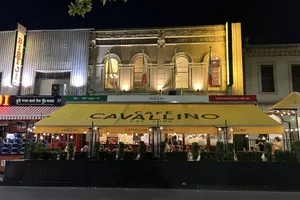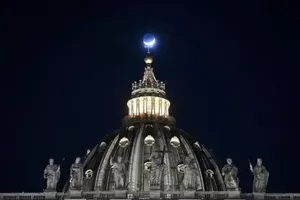Naturally, Saint Valentine was Italian and Valentine’s Day is a big deal in Italy.
The patron saint of love (as well as epileptics and beekeepers) was born in Terni, a small town in central Umbria, and lived in Rome in the third century.
Little is known of his life, though it is confirmed he was a clergyman – either a priest or a bishop – in the Roman Empire who ministered to persecuted Christians and was martyred for refusing to convert to paganism.
When he moved to Rome, Saint Valentine began to marry Christian couples in secret, allowing the husbands involved to escape conscription into the pagan army.
In order “to remind these men of their vows and God’s love, Saint Valentine is said to have cut hearts from parchment”, giving them to these persecuted Christians – a possible origin of the widespread use of hearts on Valentine’s Day.
Word of Saint Valentine’s activities spread to Roman Emperor Claudius II, who demanded that the Christian renounce his faith or be beaten with clubs and beheaded.
Saint Valentine’s refusal to convert to paganism led to his death outside the Flaminian Gate on February 14, 269.
An embellishment to this account states that before his execution, Saint Valentine wrote a note to his jailer’s daughter, whom he had befriended and healed from blindness, signed “From your Valentine”, which is said to have “inspired today’s romantic missives”.
His body was buried at a Christian cemetery on the Via Flaminia, a major ancient Roman road leading from Rome to the Adriatic coast.
For more than 200 years, Saint Valentine was one on a list of many saints whose feast days were only lightly observed at Mass.
However, in the fifth century, his story was remembered when the Catholic Church was struggling with Lupercalia, a raucous ancient Roman fertility festival celebrated from February 13 to 15.
Remembering Saint Valentine’s passion for the wedded, Pope Gelasius I decided to appropriate the pagan ritual with the saint’s feast day.
In AD 496, February 14 was named the Festa di San Valentino (Feast Day of Saint Valentine), to commemorate the martyr and replace the ancient Roman festivities.
As the centuries marched on, poets like Chaucer and Shakespeare romanticised Saint Valentine and his day of love, popularising and softening the celebration across Europe and eventually the New World.
Finally, in the early 20th century, Hallmark got involved, and here we are, amid a tornado of flowers, chocolates and cards.
Today, Italian lovers celebrate this occasion by exchanging flowers and chocolates and indulging in romantic dinners together, similar to the Australian tradition.
To add an Italian twist to the festivities, renowned Italian chocolate maker Perugina makes a special edition of its Baci chocolates.
Traditionally hazelnut-flavoured, the iconic “kisses” feature a sweet red cherry and liquid centre on February 14.
The special red foil wrapper can be opened to reveal a “love note” with a poetic phrase.
Many events unfold across Italy in the name of love around this time.
Verona, the city of Romeo and Juliet, organises an annual event full of romanticism, which is aptly called ‘Verona in Love’.
Activities include markets, guided tours, exhibitions, and music and theatre events.
Meanwhile, Saint Valentine’s birthplace of Terni celebrates the L-word not only on Valentine’s Day, but from February 1, when the celebrations, known as ‘Eventi Valentiniani’, begin with prayers in the Basilica, as well as a re-enactment of the saint’s life in full historical costume.
Throughout the month, a series of other events also take place, including a jewellery-making competition, art exhibitions and music performances, as well as the presentation of the “A Year of Loving” award, which honours a special act of love carried out by one of the townspeople.




























